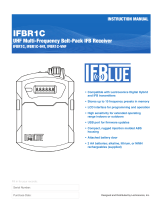
Digital Hand Held Transmitter
Rio Rancho, NM 3
General Technical
Description
Introduction
The transmitter benets from a fourth generation design
with specially developed, high eciency digital circuitry
for extended operating time on two AA batteries. The
transmitter can tune across the UHF television band
from 470.100 to 607.950 MHz (470.100 to 614.375 and
537.600 - 691.175 for export), with a selectable output
power of 25 or 50 mW. The pure digital architecture
enables AES 256-CTR encryption for applications that
require high level security.
Input Gain Range and Limiter
45 dB range of input gain adjustment allows gain set-
tings to accurately match the user’s voice and the
varying sensitivity of dierent microphone capsules. A
DSP-controlled analog audio limiter is employed before
the A-D converter. The limiter has a range of more than
30 dB for excellent overload protection. A dual release
envelope makes the limiter acoustically transparent
while maintaining low distortion. It can be thought of as
two limiters in series, a fast attack and release limiter
followed by a slow attack and release limiter. The limiter
recovers quickly from brief transients, with no audible
side eects, and also recovers slowly from sustained
high levels to keep audio distortion low while preserving
short term dynamics.
Frequency Selection
Operating frequency is normally selected using a re-
ceiver or analyzer to assess signals in the local environ-
ment to avoid interference. Once an interference-free
frequency is identied, the transmitter frequency is set
to match the receiver.
The LCD on the transmitter displays frequency in MHz
and with a two character hex code that is used on most
Lectrosonics receivers.
Antenna
A unique helical antenna allows the transmitter to be
held in any position, since the user’s hands have little or
no eect on the RF output power.
Microphone Capsules
The transmitter is available from Lectrosonics with the
HHC and HHVMC cardioid condenser capsules. Cap-
sules from several other manufacturers are also avail-
able for use with the DHu, DHu/E01: those with a 1.25”
x 28 thread pitch and three contact rings. Condenser or
dynamic microphone capsules can be used to suit the
user’s preference or the application.
Encryption
When transmitting audio, there are situations where
privacy is essential, such as during professional sport-
ing events, in court rooms or private meetings. For
instances where your audio transmission needs to be
kept secure, without sacricing audio quality, Lectroson-
ics introduces Encryption Keys. Truly entropic encryp-
tion keys are rst created by a Lectrosonics receiver,
such as the DSQD Receiver. The key is then synced
with the DHu, DHu/E01 via the IR port. The audio will be
encrypted and can only be listened to if both DHu, DHu/
E01 and receiver have the matching encryption key. If
you are trying to transmit an audio signal and keys do
not match, all that will be heard is silence or white noise.
IR (infrared) Sync
An IR Sync Port is used for quick setup with receivers
that oer this feature. Settings for frequency, step size
and compatibility mode are transferred from receiver to
transmitter via the IR ports.
Side Button Functions
A programmable switch on the side of the housing can
be congured as a mute/cough switch, a power switch
or be disabled.
USB Port for Key Transfer and Firmware
Updates
The encryption key is generated in the receiver, then
transferred to the transmitter via a USB port using a
cable. This requires that the user be in direct contact
with both units, which increases the security level.
Firmware updates are enabled by simply downloading a
le and utility program from the Lectrosonics web site,
connecting the transmitter to a computer via the USB
port and running the program.





















